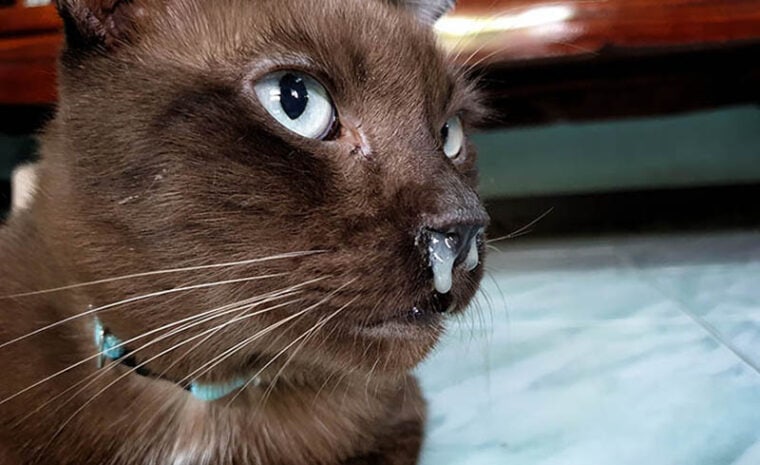
As a cat owner, it can be incredibly heartbreaking to see your cat suffer from any health issue, even if it’s as simple as a stuffy nose. This common problem among household cats occurs when the nasal lining is inflamed, resulting in feline rhinitis.
Feline rhinitis can be caused by various factors, such as foreign bodies in the nose or seasonal allergies. It can also range to severe conditions like bacterial infections or nasal cancer.
If you notice any rhinitis signs in your cat, consult your veterinarian. It’s crucial to recognize the cause and immediately provide the required treatment. Here are 10 interesting reasons your cat may have a stuffy nose or feline rhinitis.
The 10 Reasons Why Your Cat Has a Stuffy Nose
1. Viral Upper Respiratory Tract Infections
A viral upper respiratory tract infection (URTI) is the most common cause of feline rhinitis.1 It inflames the mucous membranes in your cat’s nasal passages and causes common rhinitis symptoms. Rhinosinusitis, in combination with sinusitis, is the inflammation of the lining of the sinuses. Viruses spread rapidly between cats, resulting in such infections. The most common viruses are Feline calicivirus (FCV) and Feline Herpesvirus type-1.
If your cat has eye and nasal discharge, with or without fever, it’s possible that they have an upper respiratory infection. Other signs of a URTI include intermittent and recurrent sneezing and coughing. Your cat may also lose their appetite, drool, and appear very lethargic.
In severe cases, your cat may develop painful tongue ulcers.
2. Bacterial Infections
A bacterial infection can also cause feline rhinitis due to Bordetella, Mycoplasma, and Chlamydophila, and opportunistic pathogens such as Pasteurella, Staphylococcus, Streptococcus, and other bacteria. These infections can occur alone or combined with a viral infection, which can cause more severe effects.
If your cat has a bacterial infection, they may show signs such as congestion, fever, clear to yellowish mucoid nasal discharge, and sneezing. The bacterial infection can become life-threatening if it transforms into pneumonia, so it’s best to treat it as soon as you spot the warning signs.
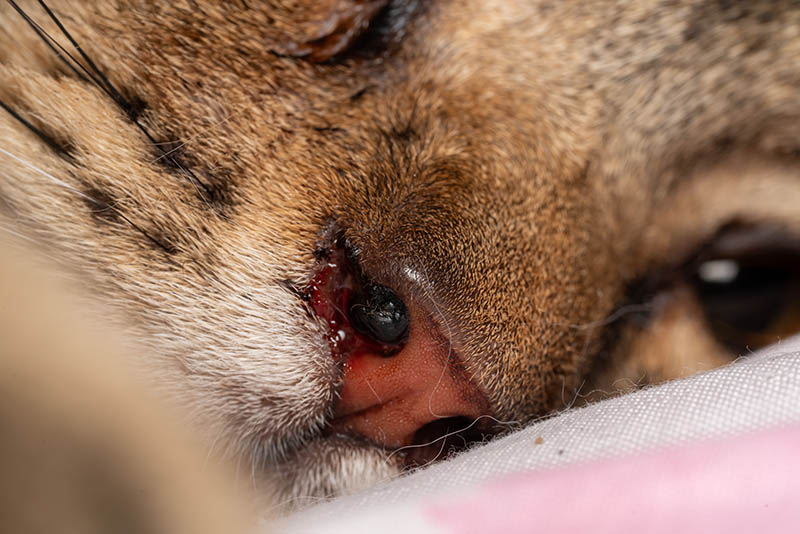
3. Fungal Infections
Fungal infections are another, though rare, reason behind infectious feline rhinitis.2 They typically occur due to environmental fungi, which can enter your cat’s respiratory system and inflame their nasal passages.
The most common fungi causing rhinitis in cats is Cryptococcus. A fungal infection is possible if your cat develops a lump on the bridge of their nose, if they also have noisy breathing, snoring, difficulty breathing, and nasal discharge and are pawing at their face.
Other signs of a fungal infection in your cat include sneezing and coughing. Such infections can cause eye problems and other neurological issues in severe cases. Other fungi that may infect the lungs and cause pneumonia and dyspnea are Histoplasma, Aspergillus, and Blastomyces.
The vet may perform nasal flushes and administer antifungal medications and supportive care to treat a fungal infection in your cat.
4. Allergies
Sometimes, your cat may have a stuffy nose due to simple allergies. Cats can develop allergies to various environmental allergies like mold, pollen, or dust.
Allergic reactions can inflame your cat’s nasal passage and result in flu-like signs. That includes nasal discharge, sneezing, and coughing. They may also experience skin rashes or severe itching.
Your vet can help you manage your cat’s allergy signs with medication or some home changes. Allergy testing is possible and can help identify the allergen, though this is not always straightforward.
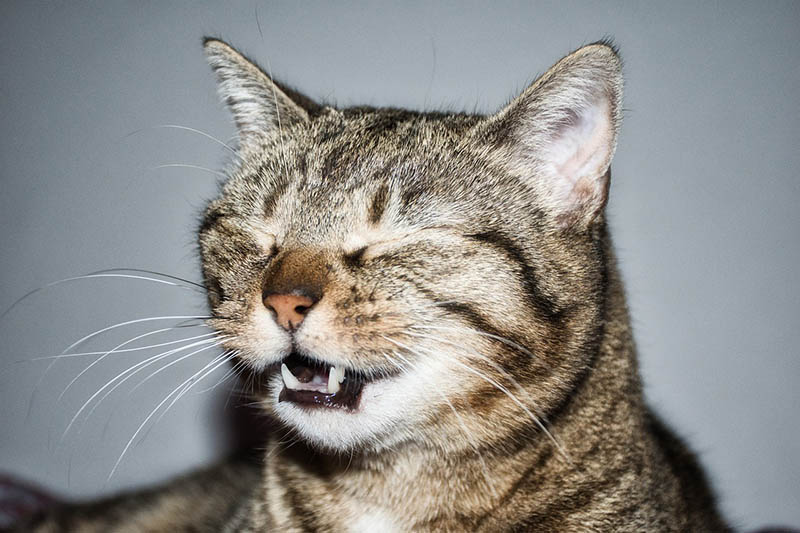
5. Parasites
Parasites can also cause feline rhinitis in very rare cases. Botfly eggs that are found outdoors can hatch near your cat’s resting spots, and the resultant larva may enter your cat’s body through their nose or mouth.
If there is a parasite, your cat may have an irritated nose or facial skin and bloody or pus-like nasal discharge. Your cat may also excessively sneeze and scratch their skin. Treatment for parasitic rhinitis involves medications to eliminate the parasite and the uncomfortable signs.
6. Oral Disease
Oral diseases like periodontal disease or tooth root disease can inflame your cat’s gums and tooth roots.4 Once the inflammation spreads to the nasal passage, it can cause nasal discharge.
If your cat has difficulty eating, along with drooling and pawing at their mouth and standard rhinitis signs, they may be suffering from tooth root disease. Your vet may recommend extractions, dental cleaning, and oral treatment to solve this problem.
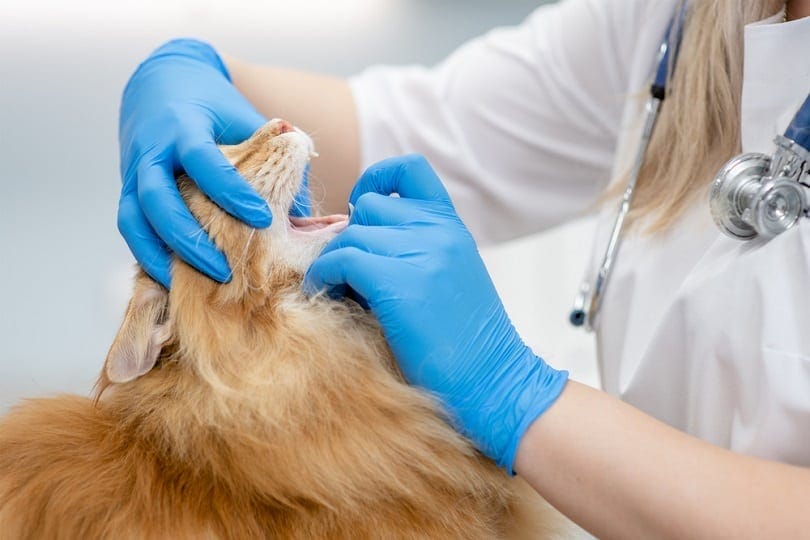
7. Nasal Cancer
Although nasal cancer is not common among cats, it can be incredibly severe. Your cat may be prone to various nasal tumors, such as lymphoma, squamous cell carcinoma, and adenocarcinoma.
These tumors can inflame the nasal passage and result in obstructive signs, such as difficulty breathing, congestion, and nasal discharge. Other signs of nasal cancer include changes in appetite or behavior, nosebleeds, and facial swelling.
The vet may perform surgery, chemotherapy, or radiation therapy for treatment based on the stage and type of nasal cancer.
8. Inflammatory Polyps
Inflammatory polyps are benign growths in the cat’s sinuses or nasal passage. Once they grow enough, they can cause inflammation and obstruction. Signs of this condition include difficulty breathing, sneezing, congestion, and nasal discharge.
Inflammatory polyps also cause middle ear infections and chronic sinusitis. It’s crucial to treat it early on to prevent such complications. Treatment for this condition involves surgical removal, but the vet may also provide medication to reduce inflammation.
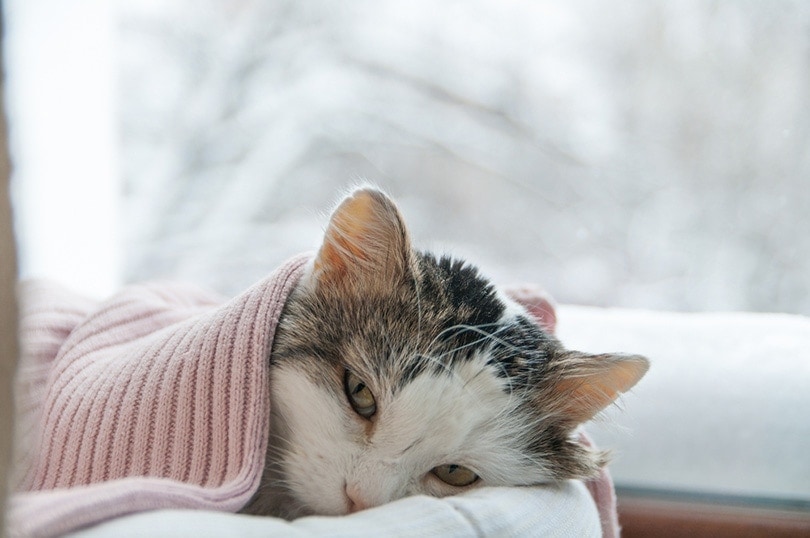
9. Foreign Body
If your cat has no infections, parasites, or tumors, it’s highly possible that a foreign body is stuck in their nasal passage. Your cat may have inhaled or ingested a small object, causing obstruction and inflammation.
These foreign bodies are usually small toys, plant material, and grass awns. Signs of a foreign body include breathing difficulties, sneezing, and nasal discharge. The vet may remove this object under general anesthesia and provide medications to manage the discomfort.
10. Idiopathic Feline Rhinitis
If the vet is unable to diagnose any specific underlying cause for the stuffy nose, it may be a case of idiopathic feline rhinitis. The exact cause of idiopathic feline rhinitis is yet to be understood. However, veterinary experts suggest a relation to genetic, immune, and environmental factors.
So, your cat may be experiencing intermittent and recurrent sneezing and nasal discharge due to idiopathic rhinitis. Even though the cause is unknown, your vet can still improve your cat’s rhinitis signs, so make sure you follow their recommendations.
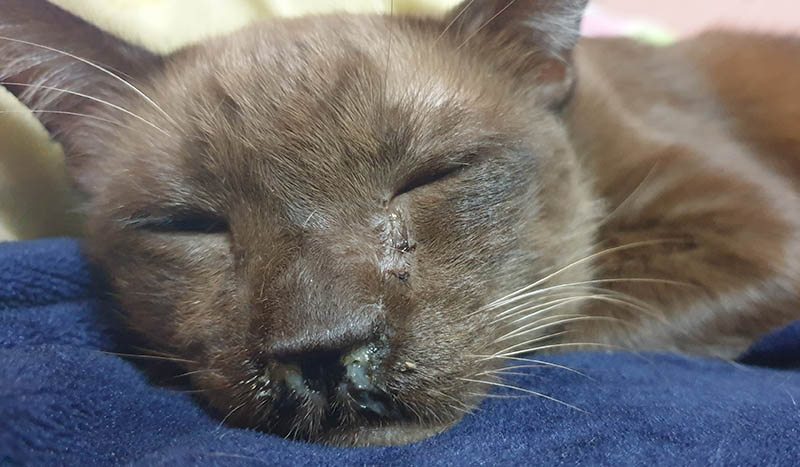
Conclusion
If you’ve read this far, you’ve probably learned why your cat has a stuffy nose. Feline rhinitis can be uncomfortable and painful for your cat, whether it’s due to a respiratory infection or a foreign body in the nasal passage.
By seeking veterinary care at the right time, you can minimize the symptoms for your furry friend. Most importantly, it can help prevent further complications in the respiratory system.
Featured Image Credit: RJ22, Shutterstock






